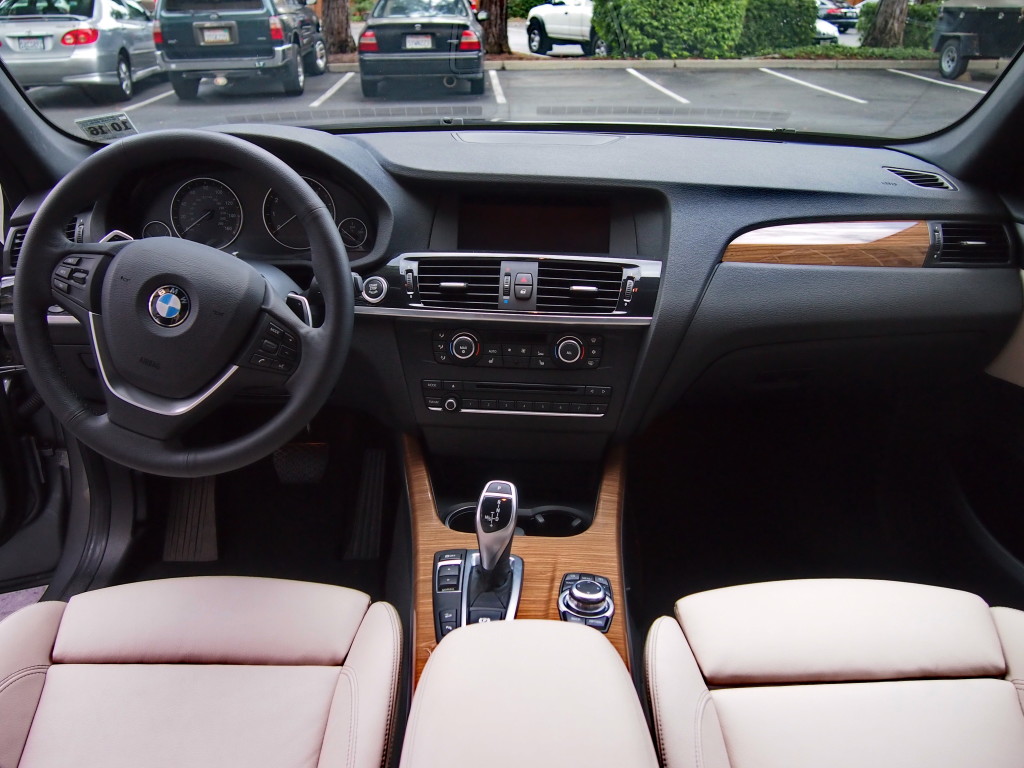New Car Review
The 2013 BMW X3
By Eric Peters
Here’s the most important thing to know about the just-updated 2013 BMW X3: Despite pressure from our Dear Leaders in DC to make more fuel-efficient engines, BMW isn’t building less powerful engines — as many others are doing. In fact, the X3’s new standard engine, a 2.0 liter turbocharged four, is stronger than the old 3 liter in-line six it replaces.
And it gets better gas mileage, too.
That’s the good news. The bad news is there’s still no diesel engine on the roster — though BMW has dropped some hints there might be by sometime in 2014.
Meanwhile, Mercedes has just launched a diesel version of the X3’s rival, the GLK and Audi’s got a hybrid version of the Q5.
One wonders why BMW is holding back. But the question for today is whether you ought to.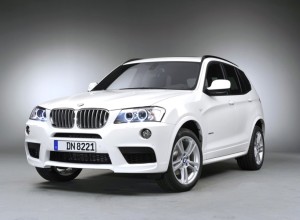
What It Is
The X3 is BMW’s entry-level CUV and competes most directly with the Audi Q5 and Mercedes-Benz GLK. Base price is $35,900 for the four cylinder-powered X3 28i and $43,900 for the X3 35i, which comes with a larger six-cylinder engine. Both versions come standard with BMW’s “xDrive” AWD system.
What’s New
The X3’s formerly standard 3 liter in-line six has been replaced by a turbocharged 2.0 liter four cylinder engine — the same unit that’s also standard equipment in the 3 and 5 series sedans. Though smaller than the engine it replaces, it produces the same hp (240) and more torque (260 lbs.-ft,. vs. 221 previously) while also using less fuel: 21 city, 28 highway vs. the old engine’s 19 city, 25 highway. To further improve efficiency, at least, potentially, BMW has made its formerly optional EcoPro driver-selectable engine management system standard equipment in all X3 trims, along with engine Auto-stop (which can be turned off). The formerly extra-cost power liftgate is now standard.
What’s Good
New four is stronger than old six. Pirouettes through the corners better than some sport sedans and better than its competition. More room inside than Benz GLK; more fun to drive than the Q5.
What’s No So Good
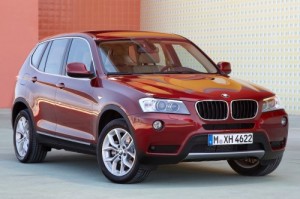 New four sounds like a four. Game Boy-style electric gear selector gives little physical feedback. Auto stop’s slight efficiency gains (maybe 1 MPG, either way) probably irrelevant to people who buy $40k cars. No diesel… yet. No manual transmission, period.
New four sounds like a four. Game Boy-style electric gear selector gives little physical feedback. Auto stop’s slight efficiency gains (maybe 1 MPG, either way) probably irrelevant to people who buy $40k cars. No diesel… yet. No manual transmission, period.
Under the Hood
The decimation of eight cylinder engines is already well under way and now sixxes are in the sights of the no-goodniks in DC. BMW is merely joining the ranks of other automakers who have been forced to nix their sixxes in favor of more fuel efficient fours, in order to comply with the fuel economy fatwas issuing from our Dear Leaders. But, unlike some of the others, BMW hasn’t downrated as it has downsized. The new 2.0 turbo four that replaces the previous 3.0 inline six not only achieves par, horsepower-wise (240) it also produces significantly more torque (260 lbs.-ft.) with all of it coming online at just 1,250 RPM — exactly 1,500 RPM sooner (well, lower in the powerband) than the old six’s 221 lbs.-ft. — which arrived at 2,750 RPM. Acceleration is almost exactly the same: zero to 60 in about 6.7-6.8 seconds. But fuel economy with the new engine is now 21 city, 28 highway vs. a less CAFE-friendly 19 city, 25 highway with last year’s straight six.
These numbers are dead heat with the Audi Q5 2.0T (zero to 60 in about 6.8 seconds; 20 city, 28 highway) and noticeably better than the Benz GLK350 (zero to 60 in 7.2 seconds and 16 city, 22 highway) which still comes standard with a six. Interestingly, this engine’s EPA stats — 19 city, 26 highway — are actually better (if just slightly) than the 2012 model’s non-turbo 3.0 six. performance.
On the Road
Don’t sweat the loss of two cylinders and the liter of displacement as far as power/performance. If anything, the new turbo four is more responsive than the old non-turbo six. The increase in torque output and the immediacy of its availability is an objective improvement. Push the gas pedal and the X3 goes right now, unless, of course, Auto Stop is on. If it is, there will be a very slight but noticeable delay in forward progress. There will also be a slight – but again, noticeable shudder/vibration as the super-fast/high-torque starter spins the engine back to life.
Which brings up Eco Pro. Like Auto Stop, this is a fuel-saving (desperation) measure, mostly there to placate the people dictating how cars ought to be built rather than those who are actually buying them. I say this because when engaged, Eco Pro mutes the performance/responsiveness of the X3’s drivetrain for the sake of ekeing out the best-possible gas mileage. But who buys an X3 for muted performance and less responsiveness?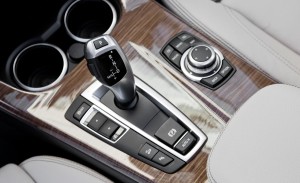
The four’s only objective weakness, as I see it, is its sound. It sounds like a four. Not bad, just like a four. The six sounds richer deeper. Not for nothing has BMW got a rep for building “driving machines.” Though a crossover SUV, which means it rides higher off the ground than a car and is also heavier than most cars its size (at 4,112 lbs., the X3 28i weighs 817 lbs. more than the 3,295 lb. 3 Series sedan it’s based on) it is nonetheless a very agile, light-on-its-feet-feeling ride. The quickness and accuracy of the steering is decidedly un-CUV, as is the way the X3’s suspension acts as a sort of centripetal force generator, keeping you in the curve, holding the line, despite the ever-increasing velocity vectors. In plain English, this thing can be leaned on.
At the Curb
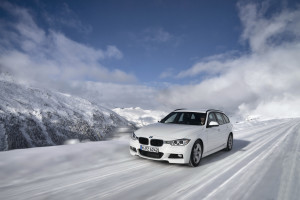 Size-wise, the X3 is significantly (about five inches, overall) longer than the truly compact-sized Benz GLK and so not surprisingly, has significantly more cargo capacity behind its second row (27.6 cubes vs. 23.3 cubes for the Mercedes) as well as almost two inches more legroom for backseat riders (36.8 vs 35.1 inches). The smaller-on-the-outside Benz does, somewhat surprisingly, have about an inch more legroom up front – 41.4 inches vs. 39,9 for the X3. The Audi Q5, on the other hand, is about the same size overall as the X3, but has a more space-efficient interior than either the GLK or the X3 with 29.1 cubic feet of trunk space as well as significantly more front and rear seat legroom (41 inches and 37.7 inches, respectively) than the BMW.
Size-wise, the X3 is significantly (about five inches, overall) longer than the truly compact-sized Benz GLK and so not surprisingly, has significantly more cargo capacity behind its second row (27.6 cubes vs. 23.3 cubes for the Mercedes) as well as almost two inches more legroom for backseat riders (36.8 vs 35.1 inches). The smaller-on-the-outside Benz does, somewhat surprisingly, have about an inch more legroom up front – 41.4 inches vs. 39,9 for the X3. The Audi Q5, on the other hand, is about the same size overall as the X3, but has a more space-efficient interior than either the GLK or the X3 with 29.1 cubic feet of trunk space as well as significantly more front and rear seat legroom (41 inches and 37.7 inches, respectively) than the BMW.
In terms of aesthetics, the Q5 and the X3 are very close. Both sit lower (65.2 inches off the ground for the Audi, 65.4 for the BMW — vs. a much more upright 66.9 for the Benz) but the X3 has the most generous ground clearance of the three: 8.3 inches vs 7.9 for both the Q5 and GLK. The Benz has a more formal — more SUV-ish — silhouette while the the Q and the X lean hard toward the sportwagony.
The Rest
I have nothing but high praise for the X3’s new 2.0 engine. It’s not quite as symphonic as the in-line six but it does maintain the performance level established by the six while achieving the uptick in gas mileage necessary to keep Uncle from breathing down BMW’s neck for awhile. Unfortunately, this will not be the end of it. As much-improved as the X3 2.0’s mileage is relative to the previous in-line six, it’s not improved enough to make the soon-to-be-in-force government mandate of 35.5 MPG average.
I still miss the presence of a manual transmission among the X3’s roster of options. It has been gone since 2011 and looks to be gone for good. Again, for reasons of economy. The thing I really miss, though, is a turbo-diesel. In Europe, BMW offers two diesel engines in the X3. A 2.0 liter and a 3.0 liter. There is a rumor that a diesel engine will become available in the X3 sometime during model year 2014. But nothing has been officially confirmed yet. Meanwhile, Benz has just put that 2.1 liter, four-cylinder diesel engine onto the GLK’s roster. Neither BMW nor Audi have anything to counter it.
The Bottom Line
The X3 is very good — as good as it probably can be, given the times. But it would be a lot better with a diesel under its hood
Specifications:
Base price: $38,850; as tested $49,450 (w/Premium, Technology and Sport packages).
Engine: 2.0 liter turbocharged four cylinder, 240 hp
Transmission: eight speed automatic
Length: 183.3 inches
Width: 74.1 inches
Wheelbase: 110.6 inches
Curb weight: 4,112 lbs.
Luggage capacity: 27.6 cubic feet
EPA fuel economy (21 city/28 highway)
Where assembled: Spartanburg, S.C.
Eric Peters is the author of “Automotive Atrocities” and “Road Hogs” and a former editorial writer/columnist for The Washington Times, a contributor to Cars.Com, The CarConnection.com and SD METRO.


